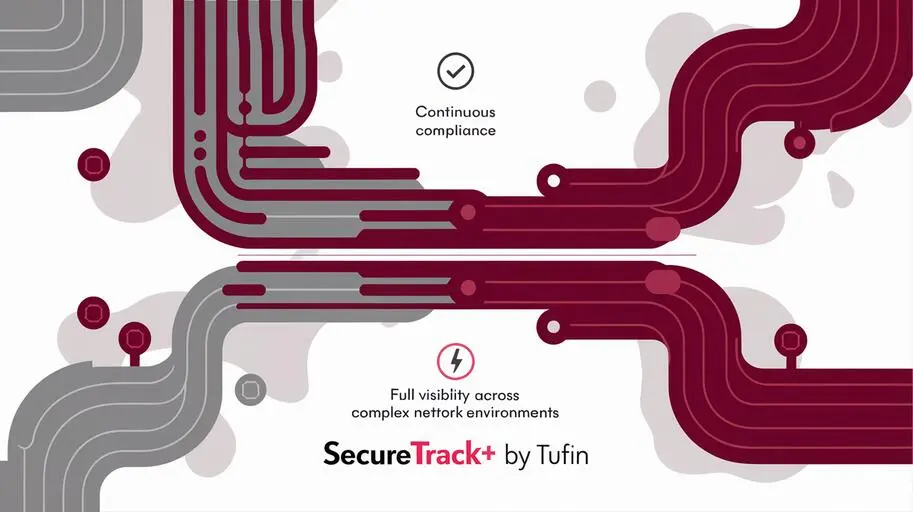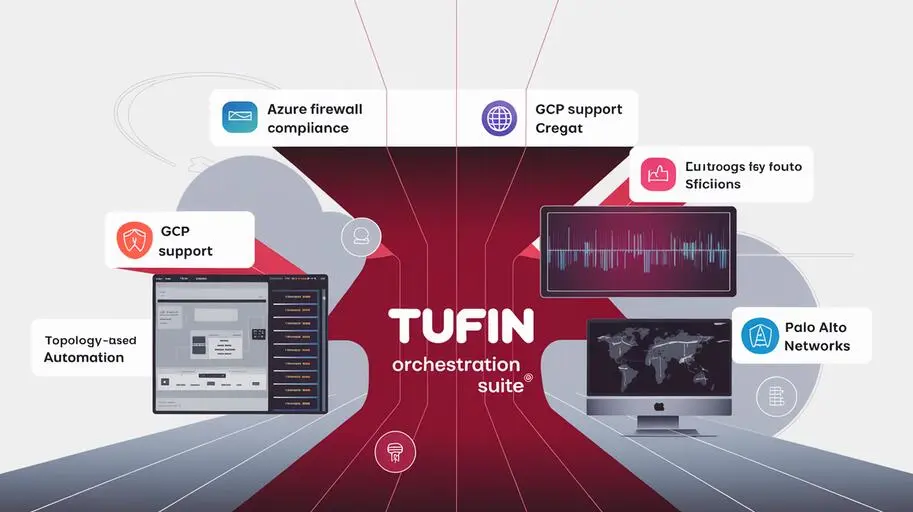
In today’s world, where cyber threats are becoming increasingly sophisticated and numerous, the effective functioning of a SOC (Security Operations Center) is critical for any organization. However, traditional security management methods based on manual processes and disparate tools are often ineffective in the face of modern challenges. Imagine a constant stream of alerts requiring immediate response, complex and convoluted firewall rules that are difficult to track and maintain, and a constant struggle for compliance. Tufin offers a comprehensive approach to security automation and significantly simplifies the work of SOC analysts by automating manual processes such as security policy change approval, compliance auditing, and identifying and eliminating redundant rules.
Why is Tufin Necessary for a Modern SOC?
Tufin is not just a tool; it is a comprehensive platform that transforms how organizations manage their network security. It provides complete visibility into network topology, device configuration, and traffic flows, automating security policies and change management, allowing SOC analysts to focus on more important tasks such as incident response and incident investigation. Tufin for Security Operations Center is your centralized security management platform.
Challenges Faced by Modern SOCs
- Complexity and Fragmentation: Modern networks are becoming increasingly complex and distributed, encompassing firewalls from various vendors, routers, cloud environments, and other components such as Amazon Web Services (AWS), Microsoft Azure, Google Cloud Platform (GCP), VMware NSX, Cisco ACI. Managing security in such an environment requires the use of many different tools, leading to fragmented data and a lack of a unified view of the security posture.
- Manual Processes: Many security management tasks, such as creating change tickets, manually checking rules for correctness, and generating compliance reports, are still performed manually, which is labor-intensive, error-prone, and not scalable.
- Insufficient Visibility: Lack of network visibility makes it difficult to detect network traffic anomalies, vulnerabilities, and other security threats.
- Compliance: Organizations must comply with numerous regulatory requirements, such as PCI DSS, GDPR, and HIPAA, which requires continuous monitoring and security auditing.
- Shortage of Qualified Personnel: There is a shortage of qualified security professionals on the job market, making it difficult to staff the SOC. Automating routine tasks reduces the burden on SOC analysts and allows them to focus on more complex tasks.
Key Components and Features of Tufin
Tufin offers a comprehensive set of solutions for security automation and simplification of SOC operations. The main components of the platform are SecureTrack, SecureChange, and SecureApp. These components can be used as standalone products or as an integrated platform. Tufin Solutions for Network Security are your comprehensive answer to modern challenges.
Tufin SecureTrack: Network Visibility and Analytics
SecureTrack provides real-time network visibility, allowing SOC analysts to understand how their network is organized, which firewalls and other devices are used, and which security policies are applied. SecureTrack collects logs from firewalls, device configuration data, and network traffic information. Network Traffic Visualization with Tufin becomes simple and intuitive.
Key Features of Tufin SecureTrack:
- Centralized Firewall Management: SecureTrack supports a wide range of firewalls from various vendors, such as Cisco, Check Point, Palo Alto Networks, Fortinet, allowing SOC analysts to manage them from a single console.
- Network Topology Visualization: SecureTrack automatically discovers and visualizes the network topology, allowing SOC analysts to understand how different devices and networks are interconnected.
- Firewall Rule Analysis: SecureTrack analyzes firewall rules and identifies duplicate rules, redundant rules, and unused rules that may pose a security threat.
- Compliance Monitoring: SecureTrack automatically monitors network compliance with regulatory requirements, such as PCI DSS, GDPR, and HIPAA, and generates compliance reports.
- Vulnerability Detection and Remediation: SecureTrack integrates with vulnerability scanning systems, receives scan results and correlates them with the network configuration to determine which devices are vulnerable and how to protect them, and helps SOC analysts identify and remediate vulnerabilities in the network.
Tufin SecureChange: Security Change Automation
SecureChange automates the process of changing access rules, from the change request to its implementation. This significantly reduces the time it takes to implement changes, reduces the risk of errors, and increases network performance. SecureChange allows you to automate security policy types such as firewall rules, routing policies, and VPN settings. Tufin Security Policy Automation allows security teams to work faster and more efficiently.
Key Features of Tufin SecureChange:
- Automated Change Request Process: SecureChange provides users with the ability to request access rule changes through a web interface.
- Automated Risk Assessment: SecureChange automatically analyzes the impact of changes on existing security policies, identifies potential conflicts and vulnerabilities, and provides risk analysis associated with each change request, and provides SOC analysts with the information needed to make informed decisions.
- Automatic Compliance Check: SecureChange automatically verifies that the change request complies with regulatory requirements and generates reports in various formats such as PDF, CSV, and XML.
- Automated Change Implementation: SecureChange automates the implementation of changes on firewalls, generating CLI scripts or performing changes through APIs, which reduces the risk of errors and increases network performance.
- Automatic Change Documentation: SecureChange automatically documents all access rule changes, which simplifies security audits and compliance.

Tufin SecureApp: Application Security Management
SecureApp provides visibility and control over application security, allowing SOC analysts to understand how applications interact with each other and with the network, and which security policies are applied. SecureApp discovers applications by analyzing network traffic, using data from configuration management systems (CMDB), and polling application APIs. Tufin SecureApp for SOC provides a complete picture of the security of your applications.
Key Features of Tufin SecureApp:
- Application Discovery: SecureApp automatically discovers applications running on the network and identifies their dependencies.
- Application Topology Visualization: SecureApp visualizes the application topology, allowing SOC analysts to understand how applications interact with each other and with the network.
- Application Security Policy Management: SecureApp allows SOC analysts to define and enforce application security policies, such as restricting access to specific data, encrypting traffic, and authenticating users, which control access to applications and data.
- Compliance Monitoring: SecureApp automatically monitors the compliance of applications with regulatory requirements, such as PCI DSS, GDPR, and HIPAA, and generates compliance reports.
- Application Lifecycle Management: SecureApp supports application lifecycle management, tracks changes in applications, ensures compliance with security requirements at every stage, from development to decommissioning.
Tufin Integration with SIEM/SOAR to Improve SOC Efficiency
Tufin easily integrates with SIEM (Security Information and Event Management) and SOAR (Security Orchestration, Automation and Response) systems, which significantly increases SOC efficiency. Integration of Tufin with SIEM provides centralized collection and analysis of security events, and integration with SOAR automates incident response processes. Tufin integrates with SIEM and SOAR systems such as Splunk, QRadar, SentinelOne, Swimlane. Tufin Integration with SIEM/SOAR is a key factor in optimizing the work of the SOC.
Benefits of Integrating Tufin with SIEM/SOAR
- Improved Threat Detection: Integration of Tufin with SIEM provides a more complete view of security threats, allowing SOC analysts to detect and respond to attacks faster.
- Automated Incident Response: Integration of Tufin with SOAR automates incident response processes, such as automatic blocking of IP addresses, adding rules to firewalls, isolating compromised hosts, which reduces incident response time and reduces damage from attacks.
- SOC Work Optimization: Integration of Tufin with SIEM and SOAR allows SOC analysts to focus on more important tasks, such as incident investigation and security improvement.
- Cost Reduction: Integration of Tufin with SIEM and SOAR allows you to reduce security costs through automation and optimization of SOC operations.
Practical Examples of Using Tufin in SOC
Tufin can be used to solve a wide range of tasks in the SOC. Here are a few practical examples:
- Firewall Management Automation: Tufin can be used for firewall management automation, including creating new access rules, deleting obsolete rules, changing existing rules, security audit and risk assessment.
- Vulnerability Detection and Remediation: Tufin can be used to detect and remediate vulnerabilities in the network, including vulnerabilities in firewalls, routers, and other devices.
- Security Incident Response: Tufin can be used to automate incident response processes, including detecting malicious activity, phishing attacks, data leaks, automatic blocking of malicious traffic, isolating compromised devices, and recovering from attacks.
- Compliance Monitoring: Tufin can be used to automatically monitor network compliance with regulatory requirements, such as PCI DSS, GDPR, and HIPAA.
- Improving Protection Against DDoS Attacks: Tufin can be used to improve protection against DDoS attacks by automatically blocking malicious traffic and optimizing traffic.
Tufin: An Investment in Security and SOC Efficiency
Tufin is not just a tool, but a strategic solution that allows you to transform your SOC and significantly increase the level of network security. Thanks to automation, network visibility, and integration with other systems, Tufin allows you to reduce risks, reduce costs, and increase the efficiency of SOC analysts’ work. Benefits of Using Tufin for SOC are obvious: improved protection, optimized processes and reduced costs.
By implementing Tufin, you get:
- Reducing the number of potential entry points for attackers by strengthening access control and timely elimination of vulnerabilities.
- Reducing the likelihood of unauthorized access to resources and violations of corporate security standards.
- Accelerating incident response time.
- Increasing SOC analyst efficiency.
- Optimizing network infrastructure control.
Ready to learn how Tufin can transform your SOC?
Contact us for a personalized consultation and demonstration.
FAQs about: Next-Generation Security Management Center Based on Automation
-
What is Tufin and how does it help a modern SOC?
Tufin is a comprehensive platform that automates network security management. It provides network visibility, security policy automation, and change management, allowing SOC analysts to focus on incident response and investigation.
-
What are the main problems that Tufin solves in modern SOCs?
Tufin addresses the challenges of network complexity and fragmentation, manual processes, lack of visibility, compliance requirements, and a shortage of skilled personnel.
-
What are the main components of the Tufin platform?
The main components of the Tufin platform are SecureTrack (network visibility and analytics), SecureChange (security change automation), and SecureApp (application security management).
-
What is Tufin SecureTrack and what capabilities does it provide?
Tufin SecureTrack provides real-time network visibility, centralized firewall management, network topology visualization, firewall rule analysis, compliance monitoring, and vulnerability scanning.
-
How does Tufin SecureChange automate the access rule change process?
Tufin SecureChange automates the change request process, automatically assesses risks, verifies compliance, implements changes on firewalls, and documents all changes.
-
What does Tufin SecureApp do for application security management?
Tufin SecureApp provides visibility and control over application security, discovers applications, visualizes application topology, manages application security policies, tracks compliance, and supports application lifecycle management.
-
How does Tufin integrate with SIEM/SOAR systems and what are the benefits?
Tufin integrates easily with SIEM and SOAR, which improves threat detection, automates incident response, optimizes SOC operations, and reduces costs.
-
What practical examples of Tufin usage in a SOC can be given?
Tufin can be used to automate firewall management, detect and remediate vulnerabilities, respond to security incidents, monitor compliance, and improve protection against DDoS attacks.
-
What benefits does an organization receive by implementing Tufin in its SOC?
Implementing Tufin allows you to reduce the attack surface, reduce the number of security policy violations, speed up incident response time, increase the efficiency of SOC analysts, and optimize network infrastructure control.
-
What does Tufin do to improve protection against DDoS attacks?
Tufin improves protection against DDoS attacks by automatically blocking malicious traffic and optimizing traffic.




